Click on images to enlarge
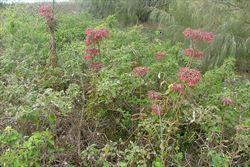
infestation in coastal sand dunes (Photo: Sheldon Navie)
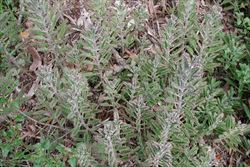
habit prior to flowering (Photo: Sheldon Navie)

habit in flower (Photo: Sheldon Navie)
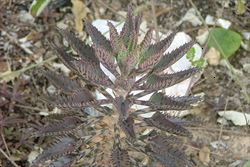
variegated leaves (Photo: Sheldon Navie)
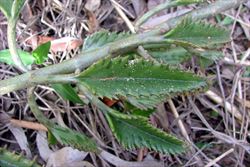
close-up of boat-shaped leaves (Photo: Sheldon Navie)
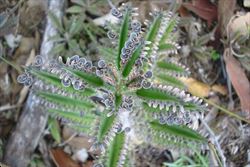
leaves with plantlets in marginal notches (Photo: Sheldon Navie)
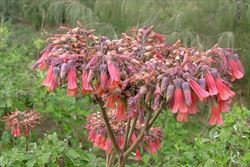
flower cluster (Photo: Sheldon Navie)
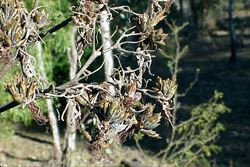
plantlets on old flower cluster (Photo: Sheldon Navie)
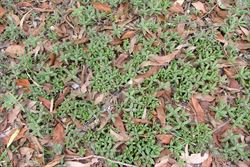
dense carpet of seedlings (Photo: Sheldon Navie)
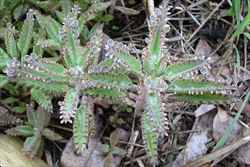
young plants and seedlings (Photo: Sheldon Navie)
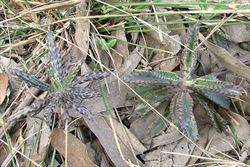
comparison of young mother-of-millions (Bryophyllum delagoense ) plant, on the left, and young hybrid mother-of-millions (Bryophyllum x houghtonii) plant, on the right (Photo: Sheldon Navie)
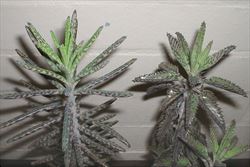
comparison of the almost cylindrical leaves of mother-of-millions (Bryophyllum delagoense), on the left, and the boat-shaped leaves of hybrid mother-of-millions (Bryophyllum x houghtonii), on the right (Photo: Sheldon Navie)
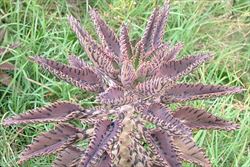
fleshy variegated leaves (Photo: Sheldon Navie)
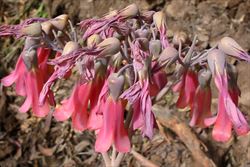
close-up of drooping tubular flowers (Photo: Sheldon Navie)
Scientific Name
Bryophyllum x houghtonii (D.B. Ward) P.I. Forst.
Synonyms
Bryophyllum daigremontianum (Raymond-Hamet & H. Perrier) A. Berger x Bryophyllum delagoense (Eckl. & Zeyh.) SchinzBryophyllum daigremontianum (Raymond-Hamet & H. Perrier) A. Berger x Bryophyllum tubiflorum Harv.Kalanchoe x houghtonii D.B. Ward
Family
Crassulaceae
Common Names
coconut plant, crossbred mother of millions, devil's backbone, good luck plant, hybrid life plant, hybrid mother of millions, hybrid mother-of-millions, mother of millions
Origin
A hybrid (possibly of horticultural origin) of two species that are both native to Madagascar.
Cultivation
This hybrid has been widely cultivated as a garden ornamental in Australia, and it can still be commonly seen growing in older gardens.
Naturalised Distribution
Widely naturalised in eastern Australia (i.e. throughout Queensland and in some parts of New South Wales). It is most prevalent in the coastal and sub-coastal districts of Queensland, from the New South Wales border north to Townsville. Also recently recorded as naturalised in Victoria and in the Northern Territory.
Because this hybrid is so similar to mother-of-millions (Bryophyllum delagoense), its distribution in Australia is probably underestimated.
Habitat
A weed of pastures, open woodlands, disturbed sites, roadsides, fencelines, embankments, waste areas, coastal environs and gardens in sub-tropical, semi-arid, tropical and warmer temperate regions.
Habit
A long-lived (i.e. perennial), fleshy (i.e. succulent) plant with upright (i.e. erect) stems usually growing 30-180 cm tall.
Distinguishing Features
- a fleshy herbaceous plant with upright (i.e. erect) stems usually growing 30-180 cm tall.
- its mottled leaves are distinctively boat-shaped, with many small teeth along their margins.
- tiny plantlets are often produced along the edges of its leaves.
- its drooping bell-shaped flowers (2-4 cm long) are bright red or reddish-pink in colour.
- these flowers are borne in dense clusters at the top of its stems.
Stems and Leaves
The fleshy (i.e. succulent), upright (i.e. erect), and rounded stems are usually unbranched (except for in the inflorescence). They are grey, greyish-green or pinkish-grey in colour and hairless (i.e. glabrous).
The fleshy (i.e. succulent) leaves are distinctively folded or boat-shaped (40-80 mm long and 8-20 mm wide), with many small notches or teeth located along their margins. These leaves are borne on almost rounded stalks (i.e. sub-cylindrical petioles) that are 10-25 mm long. Plantlets are often produced in the teeth (i.e. marginal notches) of these leaves. The leaves, and sometimes also the stems, are variegated with a darker coloured mottling.
Flowers and Fruit
The bell-shaped (i.e. tubular) flowers (2-4 cm long) are red, orange-red or pinkish-red in colour and have four petals that are fused for most of their length (i.e. into a corolla tube). They are drooping (i.e. pendulous) and grouped into tightly branched clusters at the top of the stems (i.e. in terminal corymbose inflorescences). These flowers also have four partially fused greyish coloured sepals (about 5-13 mm long), four styles and eight stamens. Flowering occurs mainly during winter and early spring.
The dry, papery fruit is a 'follicle' (about 10 mm long) which remains enclosed in the old flower parts. It is deeply-divided into four sections (i.e. carpels) and contains numerous minute seeds. This hybrid will sometimes also produce plantlets from vegetative buds that form on the branches of the old flower clusters.
Reproduction and Dispersal
This hybrid reproduces by seed and alsovegetatively via tiny plantlets that are produced along the edges of its fleshy (i.e. succulent) leaves and also on the branches of its old flower clusters. Dislodged leaves, or broken leaf parts, can also take root and give rise to new plants.
Vegetative plant parts and seeds are commonly spread in dumped garden waste. Its very fine seeds are probably also wind and water dispersed and its leaves and plantlets may also be dislodged and spread by animals, vehicles, machinery and slashers.
Environmental Impact
Hybrid mother-of-millions (Bryophyllum x houghtonii) is regarded an environmental weed in Queensland and New South Wales. It is currently of most concern in south-eastern Queensland, and was recently ranked among the top 30 most invasive plants in this region. In New South Wales it is becoming increasingly more common, particularly in the north-east of the state, and is also naturalised around the opal fields near Lightning Ridge.
This hybrid is ecological very similar to mother-of-millions (Bryophyllum delagoense), occupying the same sorts of habitats and causing the same negative environmental impacts. It forms dense infestations in grasslands and open woodlands in inland regions and also invades coastal habitats.
Other Impacts
This hybrid is very poisonous to livestock and humans. Like mother-of-millions (Bryophyllum delagoense ) it causes cattle deaths and reduces the productivity of pastures.
Legislation
This species is declared under legislation in the following states and territories:
- Queensland: Class 2 - landowners must take all reasonable steps to keep land free of this species (throughout the entire state). It is also illegal to sell a declared plant or its seed in this state.
- New South Wales: Class 3 - a regionally controlled weed. The relevant local control authority must be promptly notified of the presence of this weed and it must be fully and continuously suppressed and destroyed (Baulkham Hills, Blacktown, Cessnock, Clarence Valley, Dungog, Gloucester, Great Lakes, Greater Taree, Hawkesbury, Kempsey, Muswellbrook, Penrith, Port Macquarie-Hastings, Singleton and Upper Hunter local authority areas), and Class 4 - a locally controlled weed. The growth and spread of this species must be controlled according to the measures specified in a management plan published by the local control authority and the plant may not be sold, propagated or knowingly distributed (in the Campbelltown, Gosford, Gunnedah, Gwydir, Inverell, Lake Macquarie, Liverpool Plains, Moree Plains, Narrabri, Newcastle, Port Stephens, Tamworth, Tenterfield and Wyong local authority areas).
- Western Australia: Unassessed - this species is declared in other states or territories and is prohibited until assessed via a weed risk assessment (throughout the entire state).
Management
For information on the management of this species see the following resources:
- the Biosecurity Queensland Fact Sheet on mother of millions (Bryophyllum spp.), which is available online at http://www.dpi.qld.gov.au.
- the New South Wales Department of Primary Industries Primefact on mother of millions (Bryophyllum delagoense), which is available online at http://www.dpi.nsw.gov.au.
Similar Species
Hybrid mother-of-millions (Bryophyllum x houghtonii) is very similar to mother-of-millions (Bryophyllum delagoense) and mother-of-thousands (Bryophyllum daigremontianum). It is also relatively similar to resurrection plant (Bryophyllum pinnatum), prolific mother-of-millions (Bryophyllum proliferum) and lavender scallops (Bryophyllum fedtschenkoi). These species can be distinguished by the following differences:
- mother-of-millions (Bryophyllum delagoense) has relatively small cylindrical (i.e. terete) leaves (usually less than 10 cm long and only 2-6 mm wide) that are always simple. These leaves are greyish in colour with some darker patches (i.e. they are variegated) and have a few teeth at their tips (i.e. apical notches).
- hybrid mother-of-millions (Bryophyllum x houghtonii) has relatively small boat-shaped or folded leaves (4-8 cm long and 8-20 mm wide) that are always simple. These leaves are greyish or greyish-green in colour with some darker patches (i.e. they are variegated) and have numerous teeth along their margins (i.e. marginal notches).
- mother-of-thousands (Bryophyllum daigremontianum) has relatively large boat-shaped or folded leaves (often more than 10 cm long and 25 mm wide) that are always simple. These leaves are greyish-green in colour with some darker patches (i.e. they are variegated) and have numerous teeth along their margins (i.e. marginal notches).
- resurrection plant (Bryophyllum pinnatum) has large, broad, flattened, leaves (5-25 cm long and 20-125 mm wide) that are often compound (i.e. trifoliate or pinnate). These leaves are usually bright green or light green in colour have numerous blunt teeth along their margins (i.e. they are crenate).
- prolific mother-of-millions (Bryophyllum proliferum) has relatively large compound (i.e. pinnate) leaves with 7-11 leaflets (7-5-15 cm long and about 3.5 cm wide). These greenish-coloured leaflets are somewhat elongated in shape, flattened, and have numerous blunt teeth along their margins (i.e. they are crenate).
- lavender scallops (Bryophyllum fedtschenkoi) has small, broad, flattened, leaves (12-50 mm long and 8-25 mm wide) that are always simple. These leaves are usually bluish-green or purplish-green in colour and have numerous reddish-brown coloured blunt teeth along their margins (i.e. they are crenate).
Cotyledon (Cotyledon orbiculata) is also relatively similar to mother of millions (Bryophyllum delagoense). However, this species can be distinguished by its much broader, green or greyish, leaves that usually have a reddish-coloured margin.

